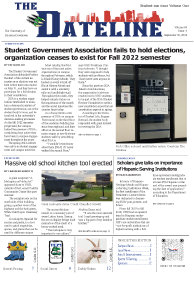Volume 69 Issue 3 Page 6 right-menu

UHD alumna Mouchaty discusses ‘How to Talk to a Nudibranch’ in art exhibition
By Madiha Hussain
Nudibranchs, also known as sea slugs, are marine molluscs without shells. Most people have gone their entire lives without encountering a single nudibranch. So, why are these seemingly insignificant creatures the subject of artist Suzette Mouchaty’s artwork?
Mouchaty explained that her Nudibranch sculptures were a response to a New York Times opinion piece about environmental problems.
“I can’t even remember what exact article it was, but the whole purpose of it was just to say, ‘Extinction is natural, so it’s okay if humans cause extinction.’ So, humans can wreck nature? In 28 years, coral reefs will become extinct unless we change,” Mouchaty said.
She further explained why she chose Nudibranchs as her inspiration.
“Well, Nudibranchs are found in coral reefs, and they symbolize the problems we’re facing when it comes to climate change,” Mouchaty said. “We lose these beautiful creatures when the coral reefs disappear.”
She also chose Nudibranchs because of how interesting they look. Mouchaty explains that Nudibranchs are fluid, colorful, and have a peculiar anatomy, which made them the perfect muse for her. Mouchaty clarifies,
“They’re not science models. They are ART that have attitude.”
Nudibranchs are typically between a quarter of an inch to 12 inches long, yet Mouchaty made her sculptures as large as people.
“I scaled them to the size of a human because you can’t ignore them anymore at this size,” she explains.
“They’re demanding, so you acknowledge them. You acknowledge that we will lose these beautiful creatures when we lose the coral reefs. They have a sexy form that draws you in, but you can’t look away because they’re mysterious and beautiful.”
Even though Mouchaty is an accomplished artist, making art is not her full-time job. She is a biology professor at UHD. In 2015, she took a break from teaching and studied for a master’s degree in fine arts at the University of Houston.
When asked how she balances her artwork and her job as a professor, she replies, “I don’t! It’s super challenging. I’m trying to balance everything. If I stay away from my art for too long, I become disconnected with the emotional impulse I need.”
Mouchaty began making her Nudibranch sculptures in 2019, and it took her several months for each one. She started by designing a small, preliminary copy with clay. She then used graph paper to sketch what she wanted, which she redrew onto a larger paper surface.
She cut out the sketch and traced it over her Styrofoam material. Mouchaty used Styrofoam to create her sculptures, one of the most harmful products for the environment, as a juxtaposition for the purpose of her artwork.
The “How to Talk to a Nudibranch” art installation in the STB building ended on Sept. 1. When asked where her artwork would go after the installation was over, Mouchaty said they would go back into storage. “They’re just too fragile to be put on display,” referring to the fact that someone must be paid to watch over them while they’re displayed. “I have been encouraged to sell them, but I can’t help but be attached to my artwork.
We hope that Mouchaty will again grace our campus with another art installation soon. As for the “How to Talk to a Nudibranch” installation, Mouchaty hopes to have a panel to discuss the problems with biodiversity and climate change in November alongside her artwork. Pictures and information of Mouchaty and her artwork can be found on her website at www.suzettemouchaty.com.
Comments or feedback? Contact The Dateline Editor at [email protected]
Submit Your News
Want to share some news? Have a hot news tip? Let us know what's going on!
Submit News

